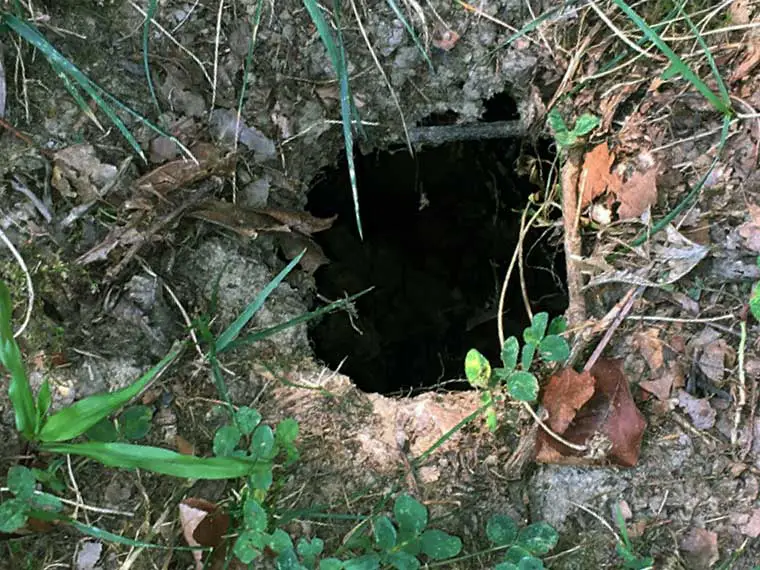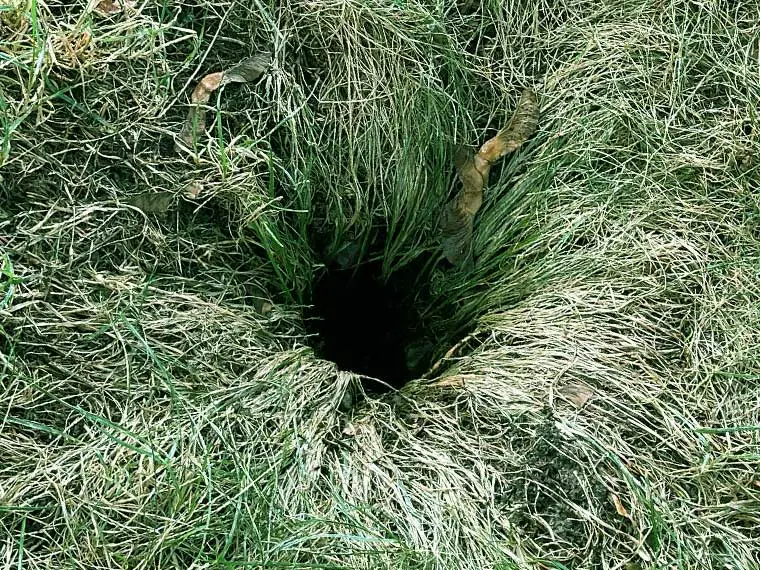Seeing lots of tiny holes in your backyard or lawn is enough to enrage most people. It’s particularly rage inducing if you’ve spent precious time and hard-earned money making the perfect outdoor environment.
I don’t blame you for being anxious if you suspect the holes have been made by voles or chipmunks, because both can cause a lot of damage. It’s not just to your yard, but also foundations and walkways.
But let me say one thing before I go on, when it comes to the chipmunk holes vs vole holes debate, there really is no winner. Both are intrusive and eat at plants, dig extensive tunnel systems, and even attract snakes to your backyard.
Chipmunks do dig larger holes than voles though. In fact, such is the extent to which chipmunks burrow and tunnel, it’s a potential risk to your home as they like to go near walls and foundations.
Vole holes on the other hand, tend to stick to the grass and near tress. But they can still be as damaging.
In this guide below, I will explain to you how you can (sometimes) differentiate between chipmunk holes vs voles holes.
I implore you to read this, because it explains why chipmunks and voles are such a problem in your backyard. Not just to plants and vegetation, but also hard standing areas such as patios and foundations.
Chipmunk holes vs vole holes: what’s the difference?
In simple terms, vole hole versus chipmunk hole differences come down to size. But that’s still not a sure-fire way of knowing who the hole belongs to, unless you see the critter coming out.
But, as a rule of thumb, vole holes are about the size of a golf ball (1.7 inches in diameter), and a chipmunk hole is a little bigger (2 to 3 inches in diameter). Here are those differences in full:
What vole holes look like in your yard
- Vole holes do not have mounds of earth outside them like mole holes do.
- Voles are about the size of a golf ball, and just under 2 inches in diameter.
- They are found on backyard lawns and often around the base of trees.
- You might also notice tracks that about 2 inches wide in the lawn where the voles are travelling between holes.
- Look for gnaw marks near the bottom of trees or plant stems.
- Look for dead plants that have had their roots eaten (here are more things they like to eat).
- Vole tunnels can go as deep as 12 inches into the earth.

What chipmunk holes look like in your yard
- Like voles, chipmunks do not leave mound of earth outside their holes.
- Chipmunk holes are bigger than vole holes, about 2 to 3 inches in diameter.
- If you see lots of holes within a 10-meter area, it possible they have been dug by chipmunks. They love to create supplementary holes which give different access point into the tunnels they create in your backyard.
- Uprooted bulbs in plant pots and garden beds.
- Multiple small holes, often near the foundations of your home or along paths.
- Seed and grain piles hidden away.
- Holes and bitemarks taken out of low-hanging vegetables and fruit.

Vole holes and chipmunk holes both present a challenge.
If I was to say I’d rather one than the other, it’s so tough. Like I said, chipmunks can cause more damage, but voles reproduce rapidly, so their population in your yard can quickly accelerate leading to even more holes and tunnels.
But chipmunk holes and tunnels can be a lot longer and deeper than vole holes.
Vole holes lead to criss-crossing tunnels under the yard grass, they can also do a lot of turf damage in spring, particular with those paths that they leave.
Chipmunks dig huge burrows that can be up to a meter in depth, and 10 meters long. They don’t stop there either. Chipmunk holes can continually be expanded year on year. They truly are the greedy property developers of the animal world.
But that doesn’t mean you don’t have both living in your yard.
Handy Hint: Chipmunk holes are very similar to rat holes. Here’s how to tell the difference.
I think I’d rather voles live in a hole than chipmunks
As you can gather, I am no fan of chipmunks, and in truth, I don’t really want voles living in my backyard either. But give me a choice, and I’d rather voles in a hole than chipmunks in a hole, and here’s the biggest reason why.
Chipmunks will eat your plants and dig holes in your backyard. Anything you have planted is fair game to them. They will also help themselves to bird seed or pet food that’s left in your yard.
But by far, the biggest reason I’d rather voles win the battle of living in a hole, is the damage chipmunks can do to property.
Chipmunks are known for burrowing under sidewalks, driveways, patios, porches, walls, and the foundations of houses. Given how extensive their tunnelling can be, it’s possible that chipmunk holes can lead to weakening and damage to property.
It will cost a lot to repair ground that has collapsed due to chipmunk activity.
Whilst vole holes can become very problematic in a backyard, it’s not common for them to damage property in the same way.
How to get rid of chipmunks and voles in your yard
If it is indeed chipmunks or voles in the holes, here are 5 humane ways you can get rid of the rodents in your backyard.
- Remove any food sources: this can include using chipmunk-proof bird feeders and keeping your clean of pet food or fruit that falls onto the lawn.
- Try an ultrasonic repellent: these devices make sounds that we can’t hear, but chipmunks can, and it could scare them off, here’s one on Amazon (or click the pic below).
- Use mesh or cages over your bulbs: if the chipmunks can’t reach your planted bulbs, it may discourage them from making holes and homes in your backyard.
- Keep your backyard tidy: this means mowing the lawn regularly and removing wood piles or gardening debris that might have given them some initial places to feel safe.
- Use an anti-chipmunk spray: some people swear that mixing cayenne pepper and water and spraying it near the holes will work.
Conclusion
In conclusion, whilst it’s not really choosing one over the other, because both can be bad, if I had to choose, I’d rather the holes belonged to voles.


